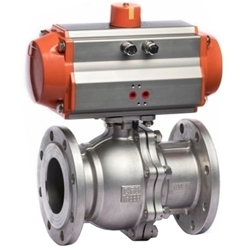Pneumatic Ball Valve Troubleshooting
Pneumatic actuated ball valve is different from manual valve. It needs to be in motion and adjustment state during use, and there are many moving parts, and it also bears the impact of various forces such as the unbalanced force of the medium. It is inevitable that various unexpected failures will occur. These failures could be actuators, regulators, and possibly from attached accessory devices. When a fault occurs, it must be dealt with and solved in time, so as not to delay the operation of the equipment of the entire project. Next, let's take a look at the common failure causes and solutions of pneumatic ball valves.
Pneumatic ball valve has no feedback signal.
 The signal line of the pneumatic ball valve consists of a pair of control signal lines and a pair of feedback signal lines. When the PLC gives a signal to the valve, the signal is converted in the positioner of the regulating valve, and the action of the valve stem is controlled by the air source pressure. The stroke of the valve stem transmits the opening of the valve through the feedback signal of the regulating valve.
The signal line of the pneumatic ball valve consists of a pair of control signal lines and a pair of feedback signal lines. When the PLC gives a signal to the valve, the signal is converted in the positioner of the regulating valve, and the action of the valve stem is controlled by the air source pressure. The stroke of the valve stem transmits the opening of the valve through the feedback signal of the regulating valve.
If there is no feedback signal from the pneumatic ball valve, use a multimeter to check whether there is voltage at each contact. To check for proper wiring connections, check for damaged signal wires, and check for loose signal wires.
The valve does not close to zero.
- It is actually closed to the zero position, but the feedback indication is not there. This is a signal problem, which can be solved by adjusting the positioner.
- It is actually not closed tightly, and the most likely cause is that the valve sealing gasket is damaged. Or the rotation of the valve stem connection is blocked, which requires dismantling the valve body during maintenance, and contacting the pneumatic ball valve manufacturer to replace the sealing gasket and add lubricating oil to the rotating part to make it work normally.
The actuator moves, but the torque is not enough.
Check the adjusting bolts at both ends of the cylinder, adjust them according to the closing condition, and lock them into place.
The valve actuator does not operate.
- Check whether the air source pressure of the inlet and outlet air filter regulators reaches the rated value, adjust the air source pressure or replace the air filter regulator according to the situation.
- Check whether the solenoid valve is blocked or not, whether the ventilation action is normal, and clear the blockage or replace the solenoid valve according to the situation.
- Check whether the air source pressure entering the actuator reaches the rated value, and check whether the speed controller is blocked.
- Check whether the friction of the valve sealing parts is too large, or whether there is air leakage in the sealing ring.
Pneumatic ball valve can be opened and closed, but the action is slow when opening or closing.
- Check whether the speed controller before entering the actuator needs to be adjusted, because with the increase of the service life of the ball valve, the change of the process pipeline and the valve requires the adjustment of the speed controller.
- Check whether there is air leakage in the cylinder. Damage to the O-ring in the cylinder may cause the valve to move slowly.
- Check whether the thrust of the spring is reduced.
- Check whether the cylinder outlet lock valve is sensitive and whether the cylinder exhaust is normal.
The actuator operates normally, but the ball valve does not operate.
- The valve core and the valve seat are stuck or the pipeline is blocked.
- The joint between the actuator and the spool is worn or dropped.
The actuator operates normally, but the valve switch cannot be in place.
- There is a foreign body stuck in the valve in the pipeline.
- The medium pressure difference is too large, the rigidity of the actuator is small, and the ball valve is not closed tightly.
- The failure of the valve body itself causes.

